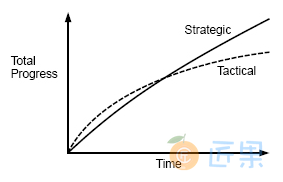那么,正确的投资额是多少?大量的前期投资(例如尝试设计整个系统)将不会有效。这是瀑布方法,我们知道它不起作用。随着您对系统的了解,理想的设计趋于零碎出现。因此,最好的方法是连续进行大量小额投资 。我建议您将总开发时间的 10%到 20%用于投资。该金额足够小,不会对您的日程安排产生重大影响,但又足够大,可以随着时间的推移产生重大收益。因此,您的初始项目将比纯战术方法花费 10-20%的时间。额外的时间将带来更好的软件设计,并且您将在几个月内开始体验到这些好处。不久之后,您的开发速度将比战术编程快至少 10–20%。在这一点上,您的投资将免费:您过去投资的收益将节省足够的时间来支付未来投资的费用。您将迅速收回初始投资的成本。图 3.1 说明了这种现象。
图 3.1:一开始,战术性的编程方法将比战略性方法更快地取得进展。但是,在战术方法下,复杂性积累得更快,从而降低了生产率。随着时间的流逝,战略方针会带来更大的进步。注意:此图仅用于定性说明;我不知道对曲线精确形状的任何经验测量。
相反,如果您进行战术编程,则可以将第一个项目完成的速度提高 10%到 20%,但是随着时间的推移,复杂性的累积会降低开发速度。不久之后,您的编程速度至少会降低 10–20%。您将很快退回在开始时节省的所有时间,并且在系统的整个生命周期中,与采用策略性方法相比,您的开发速度将更加缓慢。如果您从未使用过严重降级的代码库,请与有经验的人联系。他们会告诉您不良的代码质量会使开发速度至少降低 20%。
So, what is the right amount of investment? A huge up-front investment, such as trying to design the entire system, won’t be effective. This is the waterfall method, and we know it doesn’t work. The ideal design tends to emerge in bits and pieces, as you get experience with the system. Thus, the best approach is to make lots of small investments on a continual basis. I suggest spending about 10–20% of your total development time on investments. This amount is small enough that it won’t impact your schedules significantly, but large enough to produce significant benefits over time. Your initial projects will thus take 10–20% longer than they would in a purely tactical approach. That extra time will result in a better software design, and you will start experiencing the benefits within a few months. It won’t be long before you’re developing at least 10–20% faster than you would if you had programmed tactically. At this point your investments become free: the benefits from your past investments will save enough time to cover the cost of future investments. You will quickly recover the cost of the initial investment. Figure 3.1 illustrates this phenomenon.
Figure 3.1: At the beginning, a tactical approach to programming will make progress more quickly than a strategic approach. However, complexity accumulates more rapidly under the tactical approach, which reduces productivity. Over time, the strategic approach results in greater progress. Note: this figure is intended only as a qualitative illustration; I am not aware of any empirical measurements of the precise shapes of the curves.
Conversely, if you program tactically, you will finish your first projects 10–20% faster, but over time your development speed will slow as complexity accumulates. It won’t be long before you’re programming at least 10–20% slower. You will quickly give back all of the time you saved at the beginning, and for the rest of system’s lifetime you will be developing more slowly than if you had taken the strategic approach. If you haven’t ever worked in a badly degraded code base, talk to someone who has; they will tell you that poor code quality slows development by at least 20%.
